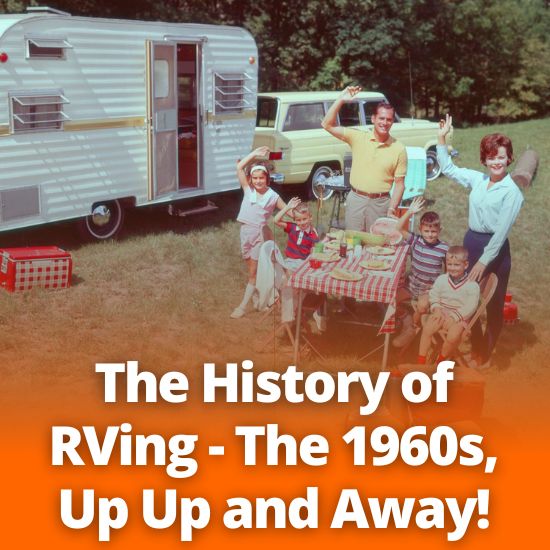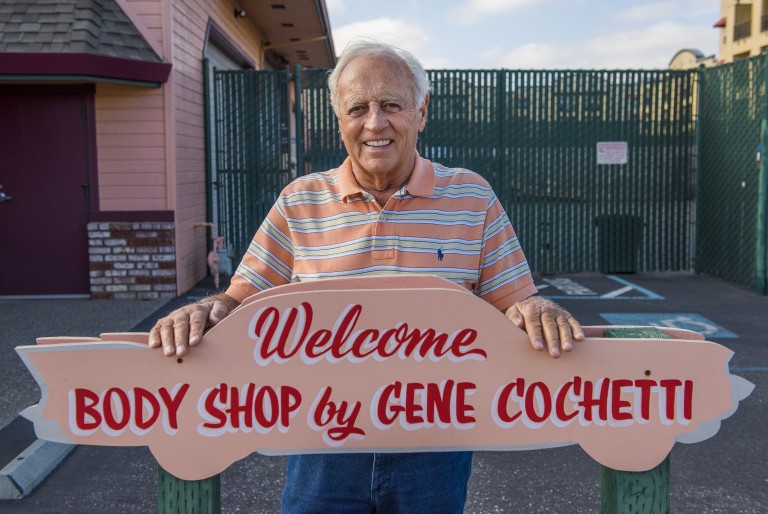
The History of RVing - The 1960s, Up Up and Away!
Ahh the 1960s, some of the wackiest years North America got to see (before the 70s, we’ll get to that). A rise of counterculture, the Vietnam War, civil rights movements, the election and subsequent assassination of JFK, the Canadian Bill of Rights became law, the Quiet Revolution in Quebec. You would think with all this the RV industry would pale in comparison – well ha I say. Because, like the Space Race that started back in the 50s, the only way to go was up!
New companies, like MEC, started popping up to make camping gear more easily available and therefore camping more accessible. RV companies followed suit, such as Jayco and Winnebago producing RVs for the everyday person instead of the luxury item/privilege, they were previously. Canadian companies like Roadtrek (then Home & Park Vehicles) and Boler became industry innovators, and RV exclusive dealerships began popping up across the country.
Organizations such as the Canadian Recreational Vehicle Association were established to maintain RV quality and safety standards.
However, up to this point there was still a common limitation of RVs that would ultimately lead to the most common RV on the road today: the trailer. By this point the average camper was not able to be disconnected from the automobile element to drive it alone. Additionally, motorhomes were, for the most part, large and limited to traveling on vehicle-friendly roads which made the wider (wilder) landscape inaccessible.
As a consequence, motorhomes remained the less common (and more expensive) choice for RV campers up into the 60s.

This decade, specifically between 1962 and 1972, saw an “astronomical rise” in both production and sales of factory-built motorhomes. The numbers might seem low to us now, but then there were reported sales of 500-600 motorhomes each year, exponentially growing into the 70s when, in 1972, manufacturers reported sales of more than 100,000 units annually. And while this inspired many small local motorhome businesses to crop up, they died off in the early 70s’ fuel and interest rate crisis.
Tech Upgrades
So camping was becoming more popular, more mainstream and with that RV designers began experimenting with new and improved ideas. “Thermo-Panel” wall insulation was invented and still used to this day! By 1965, the majority of vehicle manufacturers offered tow packages, and thanks to the more powerful tow vehicles available for the average Joe, more luxurious towable campers hit the scene.
By this decade home luxuries were becoming standard throughout RVs, this included built-in fridges for added convenience no matter your RVing style. A good thing indeed as RVs were becoming more popular and backpacking/camping was becoming a part of pop culture across North America. Things like passenger vans/commercial delivery vans were popular with families; companies such as Volkswagen, lead US manufacturers to modify vans to create more family oriented camping vehicles.
These included the Ford Falcon Econoline, Dodge Sportsman, and Chevrolet Corvair Greenbrier, with features like a pop-up roof with either canvas sides or an expandable top, some companies removing the roofs entirely to replace them with “bubble-like” fiberglass.

If you haven’t caught on, these were some of the precursors to the Class B motorhome we know and love today. But really, the true king is one Ray Frank back in the 50s. Frank was the first to use the moniker “motor home”, the colloquium quickly adapted by both campers and manufacturers alike as quickly the previously popular term “house car” faded from use.
Motorhomes Evolve
From Frank’s initial design, the three Classes emerged (although type A was much slower than B or C). Although many customers were already familiar with larger converted bus styles (that had been around since the late 20s) and the first factory-built Class A were “prohibitively priced for most buyers.”
In 1965, RV manufacturers did not include purchase options for motorhomes separately, only as a postscript to trailer manufacturing. In fact motorhomes were among the most expensive options and primarily only purchased by the wealthy. Motorhomes weren’t the “big thing” rather there was something of an evolution of the truck camper, which we’ve barely skimmed to this point. The majority of trailer companies were building truck campers that slid-in, a few offering chassis-mounted campers.

Scholar and writer Clay Jenkinson stands with Steinbeck’s Rocinante on display at the National Steinbeck Center in Salinas, California
A Camper Interlude: The Rocinante
RVs have long been used to reconnect, with each other, with the world, with ourselves. Author John Steinback, famous for literary mainstays such as Of Mice and Men and The Grapes of Wrath felt much the same at 58. In 1960, he packed up his green GMC, ¾ ton pickup truck with his sturdy camper The Rocinante in the bed, his French poodle Charley in the passenger seat and took to the open road in the hopes he could reconnect with the American people. The result of which would be Travels with Charley, published in 1962. In the words of writer Clay Jenkinson who got to sit in the famous camper, “[Steinbeck] wanted to prove that he was still a great writer and a man of virility, capable of traveling the country solo in a heavy rig without power steering.”


(The man responsible for the Rocinante’s restoration, Gene Cochetti. Jon Sall Photo)
The camper itself has a double bed, 4-burner stove, heater, fridge, and lights operating on butane, with a chemical toilet, closet space, storage space, and screened windows. An all maple interior with chrome finishes, the Rocinante was almost lost if not for Gene Cochetti, whose Auto Body Shop in downtown Salinas, California restored the truck camper back to full working order after it was delivered to his body shop in 1990.
Class C's Humble Roots
However, while sticking to a small footprint some builders began to enlarge the campers to the point where they were required to remove the bed of pick-up trucks entirely and attach the oversized campers to the chassis itself. Sure, the portability was eliminated in those cases but it improved the use of that style of camper for families. Now are you picturing that in your mind? A ‘trailer’ mounted to a vehicle chassis with a truck cabin in the front? Perhaps an overhang shall we say over the cab?

Yeah, bet you didn’t think truck campers and Class C motorhomes were connected like that! Those mods eventually evolved into Class Cs, but truck campers were still here to stay; they just went back to the smaller, more portable options we have on the road now. Of course the less-is-more mentality showed in “Class B” style conversions, with a few companies such as Adventure-Line, converting step van delivery vehicles into “motor coaches.”
Winnebago Reigns
But Winnebago changed the whole scene of motorhomes in 1966. There was a gap in the market where manufacturers thought that making pricey motorhomes was the only way to go, Winnebago saw that and said “bet,” and rolled out the F-19 motorhome for only about $5,000 USD (for the record, that’s about $48,000 USD today). The first assembly-line produced motorhomes,they advertised it as “America’s first family of motorhomes” affordable to the average middle class. By the end of the decade, Winnebago was the number one manufacturer of travel trailers and motorhomes – makes sense that the word Winnebago is synonymous with RV these days.
Having lowered the baseline price, Winnebago created demand for product across the industry. And not to be outdone, several companies began producing high-luxury Class A coaches. Barth, Blue Bird, Foretravel, and Newell began development, and in 1969 each began to experiment with rear engine “pusher” chassis. From there, diesel power would be introduced in the 70s.
A familiar face, the Pace Arrow (introduced by Selgran Inc. in 68) hit the scene, acquired by Fleetwood Enterprises in 1969 to quickly become their first flagship motorhome brand.

(A restored 1969 D22 Motorhome – very similar in design to the F-19)
The Suburban Daydream

Beginning in the 1950s, camping became a well-known, mainstream activity – right up there with drinking coffee with the morning paper. Families in particular found it a favorite pastime, flooding campsites across Canada and the USA, seeing them as the “suburban ideal”. The press even called it the new stage for the nuclear family (well, I’m paraphrasing), but camping was perfect for a low-cost vacation for the baby boomers, promoting a sense of “family togetherness” and perfect for performing the “idealized [traditional] family roles.”
The claim was that “a camping vacation costs little more than staying at home, once you’ve got the camping equipment,” which (as we all know) really required more than an asterisk of info, but this was what popular media touted then (and honestly continues to do a lot these days) but to be fair, it’s not an entirely incorrect statement.
10th Mountain Division veteran Hal Burton wrote a magazine article in 1954 that effectively encapsulated the allure of the “tamer pleasures of family camping.” He described “happy, flushed youngsters [romping] among the birches…men chopping firewood or just relaxing…[greeting people] with a friendly “Hi”…mother [keeping] one eye on their tots, and the other on food sizzling over open fireplaces.” The benefits of suburbia without the stagnancy of white picket fences: supplied firewood (i.e. free heating, gas for cooking, etc.), daily trash collection, public utilities and “tidy homesteads.” A rose-tinted view that he wrote seemed to “wipe out lingering Depression-era suspicions of camps as refuge for the down and out.” Now, camping was an acceptable, popular multi-class activity that was “better at achieving the suburban ideal than suburbia”.
(How many times can I say suburban or suburbia, my goodness…)
But in a time when the push for the nuclear family and “family roles” were attempting to be more strictly held and revered, the imperative of “family togetherness” was supported by activities like camping that popular culture at large appeared to claim was uniquely effective.
Now whether that was achieved (or is to this day) is more of a case to case basis (hello YouTube influencer mommy bloggers who force your family of twelve to live in a 20-foot camper – that’s not togetherness that’s cruel) but overall the sane RVer, whether individual, couple, family, or any configuration, don’t camp out of necessity but enjoyment. I mean, that’s why you’re reading this I assume? That RVing is a passion and not an obligation bittering undertaken.
So whether those idealized gender roles and dynamics, in and out of family structure, were really held to..I dunno…but it’s a good example of a world and society that was recovering from (and still enduring) certain fears, dangers, and tensions. Whether that be the Cold War and the social conflictions and paranoia inherent, from a North American (and specifically United States’) point of view where the family unit was seen as a bolster to, and crucial cog, in a capitalist society, camping was a direct example of the moral superiority over communism being promoted – promoting greater social and family stability and solidarity, as well as nurturing a consumer economy. But, the great sociological study of this topic is probably better suited for someone else, however to cap this all off I’ll leave you with the following:
Camping and RVing had become an influential and prominent example of modern life. It showed a sustainable image of leisure; achievable by anyone, with RVs and camping equipment becoming affordable and accessible. And for those searching for togetherness and community, camping was the ultimate experience for that and more!

